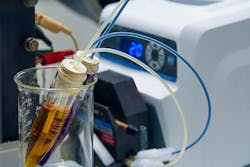Jon Wellinghoff says he does not worry about power outages anymore.
“I just bought an electric vehicle, actually, and now I have 100 kW of storage sitting in my garage, and I also have two Tesla Powerwalls. So, in my house that never peaks over 3 kW, I now have 15 or 20 times my peak that I’m able to store,” the former Federal Energy Regulatory Commission (FERC) chairman said of his home in Berkeley, California, U.S.
Wellinghoff said electric cars like his Ford Mustang Mark E have been a factor in grid-scale batteries becoming cheaper, more efficient and used by utilities in a growing variety of applications.
“There are some technology advances taking place, and manufacturing processes are being streamlined. Production is ramping up, so you’re seeing economies of scale. There’s now a greater demand for batteries,” Wellinghoff explained.
Battery energy storage is unlocking more value for utilities than in the past.
“They can stack value with the services they provide to the grid. They want to use a battery in [PJM Interconnection] for volt/VAR support. That’s a new application for energy storage and it used to be done exclusively by generators,” Wellinghoff noted.
Unlocking Value
Wellinghoff is far from the only person who sees big things ahead for energy storage.
When asked who wants to buy into energy storage today, Jason Burwen, interim CEO of the U.S. Energy Storage Association (ESA) — a trade group that represents all forms of energy storage — said: “Everyone. Five years ago, it was mostly independent power producers. Now it’s regulated utilities, smaller forward-thinking coops, all kinds of utilities.”
Burwen said that, while California would remain a leader for the time being, smaller utilities and coops in places like Arizona, Colorado, Indiana and Idaho are making their first major steps into energy storage at the project stage.
“As those utilities retire old fossil capacity, they see energy storage with renewable as providing replacement capacity,” Burwen explained. “Florida has a 490-MW battery supposed to come on-line this year.”
According to Burwen, cell prices for batteries dropped 90% over the last decade and, as production ramps up, the economies of scale effect is making itself felt.
“What’s dropping is the cost of battery supply for vehicles, and grid batteries get to ride the coattails,” Burwen said. “There are now more players coming into the space.”
This is leading to utilities and grid operators thinking of using batteries in ways that previously would not have been economically feasible.
“So, whereas grid batteries were only providing ancillary services as recently as six years ago, you are seeing them deployed to contribute to resource adequacy,” Burwen said. “I’ve noticed an increasing value for having higher power in your asset. So, even if you see, for example, a 2-hour battery, it might be a high-power battery and it will be operating for 4 hours of capacity, but it has the option to discharge a lot of energy in an hour, if needed. These are extremely flexible and configurable assets.”
Maturing Technology
Today’s batteries offer enough flexibility to be useful in a greater variety of applications, and energy storage now can complement different types of projects.
“So, the question becomes, what kind of capability do you need? What kind of value do you want?” Burwen asked. “The analogy here is what was smartphones competing against? Land lines? People wouldn’t have estimated that smartphones would be competing against basically all consumer electronics.”
Energy storage is even maturing to the point where it can take the place of building a new power generation asset or building grid upgrades.
“When you add storage to your mix, everything becomes more flexible. You can increase hosting capacity of a transmission circuit without having to build a lot of new facilities. So, it’s easy to think of it as a competitor, but what it really is, is more of an enabler and a partner,” Burwen said.
While Lithium-ion (Li-ion) is the dominant battery technology for grid-scale applications, other electrochemistries are presented as having life-cycle or duration advantages over Li-ion. When asked which battery technology was the best, Burwen said, “I love all my children” and would not say one is better than the other. However, he did say that each has their pros and cons.
According to Vince Sprenkle, senior advisor for energy storage at Pacific Northwest National Laboratory (PNNL), several battery chemistries could challenge Li-ion in the future and, in most cases, they are being designed with grid-scale energy storage in mind. These battery chemistries include the following:
1. The power and energy components of redox flow batteries are independent and situated like a car — where the engine is the flow battery stack that delivers power and the gas tank is the flow battery electrolyte that provides the range, or discharge duration, based on how much fuel is in the tank. According to Sprenkle, the separation of these components enables greater flexibility, so they may be tailored to specific uses depending on how much power and battery life are needed and in what ratio.
2. High-temperature sodium systems use a ceramic electrolyte to move sodium between a molten metal anode and sodium sulfur or nickel metal halide. Sodium-sulfur systems have been shown to deliver full energy over 7 hours. Nickel metal chloride systems offer a flexible discharge duration of 3 hours to 10 hours. Because of the molten metals used, high temperatures are required. This offers the advantage of being useful in temperature extremes that would make conventional batteries less efficient.
3. Sodium-ion batteries can be built in the same factories as Li-ion, but swap Lithium for sodium for cost benefits and an easier-to-maintain supply chain. Using cheaper materials to make essentially the same battery could cut costs by around 70%, Sprenkle said.
4. Zinc batteries, like nickel zinc (Ni-Zn) or zinc manganese dioxide, are at various stages of development, with more advancement in Ni-Zn chemistry. The advantages are higher specific energy and lower cost as well as safe operation, Sprenkle said.
“Increasing renewable generation and need for improved grid resiliency are driving storage solutions that can provide power over days, weeks and even seasons. Conventional batteries, such as Li-ion, may not best suited for these applications as the costs increase significantly with increasing discharge durations,” Sprenkle explained.
Flow batteries and other technologies may enable longer-duration systems to eventually be cost effective for 100-plus hours but will still have a challenge with seasonal shifting energy because of self-discharge, Sprenkle said. Self-discharge, which occurs at higher temperatures, is when batteries have internal chemical reactions that reduce stored charge without being used. Ambient conditions like temperature impact the round-trip efficiency of the complete energy storage system.
As for the service life question surrounding battery technology, Sprenkle said this can be improved on by using the right technology for the right application. Li-ion batteries degrade faster when maintained at a high state of charge, for example, while the opposite is true for lead-acid batteries. Charging at high rate can damage Li-ion and zinc-based chemistries, whereas some lead-acid cell designs prefer a high charge rate.
Wellinghoff said that, while his area of expertise is policy and the energy market — and he “only knows enough about electrochemistry to be dangerous” — he is skeptical of newer technologies that have yet to show they can constitute a large share of the battery market.
“There are multiple other chemistries beyond Lithium, that’s true. I have yet to see one that is a clear, breakthrough winner,” Wellinghoff said. “Vanadium has been around a while, but it’s still struggling to gain any kind of significant market share.”
He added that many in the industry think of battery storage being only large-scale utility storage in front of the meter, but behind-the-meter storage also should be considered.
Behind-The-Meter Opportunity
Speaking of his home in Berkeley, which has energy storage as well as solar panels and an electric vehicle, Wellinghoff said this array of technologies delivers potential benefits to utilities that he as a consumer might not have had in mind.
“I didn’t buy it to support the grid. I bought it to take me to the store or protect me from blackouts, like the one we had here last October. So, the price doesn’t matter so much. The price is baked into some other use,” Wellinghoff explained. “So, if [the California independent system operator] says if you make some of that energy storage available to us every month, I will pay you US$20 a month. That’s great. I’ll take that.”
Wellinghoff added that FERC’s Order 2222 will enable this sort of market participation. The policy will allow distributed energy resource (DER) aggregators to function as market participants and use their resources in a way that accommodates their physical and operational characteristics.
“It’s about what the consumer who may have storage behind the meter is using it for, multiple purposes [like] driving around, going to the supermarket, protecting themselves from blackouts,” Wellinghoff said. “I may be willing to use parts of my resource to protect the grid if I were compensated for that. So, you get a lot more and multiple uses for the asset when it’s behind the meter.”
Using batteries this way has been made cost-effective by the improvements shown by battery technology in the past two decades.
Greg Dixon, CEO of Voltus Inc., a software company that packages DERs together for commercial, industrial, residential and institutional customers, said batteries are going through a “virtuous cycle” right now.
“Batteries are going the way solar has for the past 20 years. Density, cost, integration — everything has been improving to make it a cheaper source of energy. It’s a virtuous cycle: more application, more demand, more capacity,” Dixon explained.
Dixon also drew a comparison in the way these resources can be pooled with how computer science has advanced.
“Think about computing in the ‘70s. It was just mainframes. Nothing was networked. Now, we have everything networked; it’s nothing but [that]. Power is moving that direction, too,” Dixon said.
New Battery Uses
Dixon agreed with ESA’s Burwen that all sizes and types of utilities now are getting into batteries.
“Battery energy storage is a great dancing partner for intermittent renewables. Just about every utility is trying to use more renewables. The simple answer is they all are,” Dixon said.
Jon Newman, market applications associate at Fluence Energy, a joint venture of Siemens and AES Corp. that is developing large energy storage projects in more than a dozen countries, said the front-of-the-meter energy storage market is dominated by independent power producers with one-term power purchase agreements.
“That’s where we see most of the growth, most of the megawatts. Utilities directly owning projects are becoming more scarce and we see this as a trend that will continue,” Newman said.
The flexible peaking capacity of energy storage batteries is rising to challenge natural gas-powered peaker plants, he said, and the batteries are flexible enough to be used in other ways. For example, his company is looking at energy storage as a transmission asset.
“We are very bullish on this. We use the acronym VTL: virtual transmission line. You might see this also called storage as a transmission asset. In our view, this is a major growth opportunity for utilities to deploy capital and increase their resilience,” Newman explained.
According to Fluence, VTL can add transmission network capacity faster and at lower cost than traditional pole and wire projects. A solution of this type was proposed by Fluence in Australia and would use a pair of 250-MW facilities.
Newman said the mature state of energy storage is addressing the efficiency issues temperature extremes introduce to batteries.
“We have packages that can harden the battery against cold or hot weather,” Newman noted. “We have batteries in very hot places, in the desert in Chile, and also in cold places like [the Northeastern U.S.] and Northern Europe. We have one that’s even north of the Arctic Circle.”
Regarding life-cycle issues, Newman said Fluence looks at battery arrays as 20-year lifetime assets, perhaps longer.
“The batteries do degrade along time, but built into the system is overbuild when the system is new or augmentation by adding cells to an existing system to maintain its power rating. It’s almost considered an O&M cost,” Newman said. “Doing this doesn’t disrupt the normal operation of the system.”
As a company, Fluence is technology agnostic and constantly reevaluates the technologies it uses. Newman said flow batteries and hydrogen-based energy storage are on Fluence’s radar.
“All techs have different roles to play on the grid, and they each have things they excel at,” Newman said.
Hydrogen, A New Storage Fuel?
Hydrogen could be a pathway to achieve 100-plus hours of energy storage, PNNL’s Sprenkle said. Excess electricity is used to split hydrogen from water. The hydrogen is stored either in high-pressure tanks or naturally occurring caverns and then fed into a fuel cell to make emission-free electricity.
“Declining electrolyzer and fuel cell cost will enable greater adoption of these systems, but the biggest challenge may be the low round-trip efficiency of the process. Taking account of the losses in generating the hydrogen, the energy required to compress and store it, and then the additional losses when converting hydrogen back to electricity — these systems may only be 30% to 40% efficient compared to batteries that can accomplish the same at greater than 80%,” Sprenkle said.
Because of these losses, the power generated by the process must be worth nearly twice the input just to break even, Sprenkle added. Making hydrogen this way is more valuable as a feedstock for chemical processes or a transportation fuel than it is for converting it back to electricity.
“Improving the round-trip efficiency of these systems will help the economics, but ultimately the resiliency gained from long-duration storage systems like hydrogen will need to be recognized and monetized appropriately,” Sprenkle added.
One application for hydrogen power, Wellinghoff said, could be using it in existing power plants whose owners want to get away from fossil fuels.
“Hydrogen does make sense at a site that has available interconnection into a large amount of renewables. Hydrogen can be produced at that site and used in a power plant,” Wellinghoff said. “So, I think hydrogen has a role to play with helping use off-peak renewable power that would otherwise be curtailed or dumped.”
Wellinghoff said he does not see this as being cost competitive with conventional battery storage.
Burwen said there is enthusiasm for hydrogen because it offers an answer to the life-span problem batteries have, and it can be transported somewhat easily to other places, unlike large, heavy batteries.
“There’s questions as to what that looks like, but folks are starting to pilot projects. There’s a stage where you take it from the lab to the pilots,” Burwen said. “NextEra Energy has a pilot project planned, and I suspect there will be more underway. [The Los Angeles Department of Water & Power] is premising their decarbonization on a hydrogen strategy.”
For More Information
ESA | https://energystorage.org
Fluence Energy | https://fluenceenergy.com
Pacific Northwest National Laboratory | www.pnnl.gov
Voltus | www.voltus.co
About the Author
Jeff Postelwait
Managing Editor
Jeff Postelwait is a writer and editor with a background in newspapers and online editing who has been writing about the electric utility industry since 2008. Jeff is senior editor for T&D World magazine and sits on the advisory board of the T&D World Conference and Exhibition. Utility Products, Power Engineering, Powergrid International and Electric Light & Power are some of the other publications in which Jeff's work has been featured. Jeff received his degree in journalism news editing from Oklahoma State University and currently operates out of Oregon.




